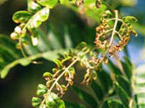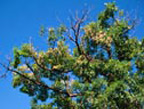Most
Common Tree Insects
|
| 
Photo
by Whitney Cranshaw
Colorado
State University
www.forestryimages.org
|
Birch
Leafminer
This
insect can be very damaging to birch foliage in May and June.
It causes brown patches on leaves which expand and can kill them
entirely. Repeated defoliation can tax the vitality of young birches.
Damage can be prevented with several methods of treatment to maximize
effectiveness and minimize environmental impact. |
|

Photo
by Whitney Cranshaw
Colorado
State University
www.forestryimages.org |
Honey Locust Plant Bug
High
populations of this insect have been found across the metro area
in recent years. Outbreaks can defoliate a mature tree within
weeks after leaves emerge in late spring. Control of this insect
can be achieved in a variety of manners. |
|
| |

Photo
by Scott Tunnock
USDA
Forest Service
www.forestryimages.org
|
Scale Insects
Several
species of scale insects damage many common landscape plants.
Scale insects attach themselves to a plant beneath a protective
cover, making control more difficult. They feed on sap, reducing
plant vitality and causing dieback. Treatment must be tailored
to the species of scale insect. |
|

Photo
by Peter Kapitola
State
Phytosanitary Administration
www.forestryimages.org
|
Mites
Mites
can be found on nearly every coniferous plant in the landscape.
Mite populations can explode in a single season with hot dry conditions,
turning interior foliage yellow to rust-brown. With established
populations, a long-term treatment and monitoring program needs
to be maintained for adequate control. |
|
|
Sawflies
Sawflies
are very damaging to mugho pines. They can also affect other pine
and spruce trees by consuming needles in feeding groups. This
insect can disfigure and shorten the life of a young spruce or
pine. Treatment and properly-timed monitoring can easily control
this insect. |
|
|
Spruce Gall Adelgids
Adelgids
are insects whose feeding stimulates gall formation in spruce
trees. The galls resemble pineapples and shelter young insects.
Gall formation can make a young tree unsightly and can kill branches.
A single spray treatment in the early spring provides effective
control. |
|

Photo
by Steven Katovich
USDA Forest
Service
www.forestryimages.org
|
Two-Lined Chestnut Borer in Oaks
Damage
from this insect, which is attracted to stressed oak trees, can
be difficult to distinguish from oak wilt and drought stress.
Two-lined chestnut borer feeding causes branches to thin and die
back. Control often requires multiple insecticide applications
coupled with removal of infested limbs. |
|
NO
PHOTO AVAILABLE AT THIS TIME |
Bronze Birch Borer
Birch
trees in the urban environment are often stressed, attracting
this insect. Bronze birch borer larvae feed on the inner bark,
causing the canopy to thin and die back. A comprehensive treatment
plan should include insecticide applications, regular fertilization,
mulching and pruning to remove infested branches. |
|

Photo
by John Weidhass
Virginia
Tech, Dept. of Entomology
www.forestryimages.org
|
Aphids
Aphids
can damage a variety of landscape plants by curling and distorting
leaves, stunting growth and causing chlorosis (yellowing of leaves).
This insect can be very damaging to plants when populations go
unchecked. Monitoring and spray treatments are effective for control.
|
|

Photo
by Whitney Cranshaw
Colorado
State University
www.forestryimages.org
|
Ash Flower Gall Mites
A
conspicuous aesthetic problem found in many ash trees. Mite activity
stimulates the formation of green colored galls that turn brown
and persist. Galls are chiefly an aesthetic problem but can cause
a decline in the health of heavily infested trees. Control of
the flower galls is difficult, and most treatments focus on increasing
the vitality of susceptible trees. |
|
|

